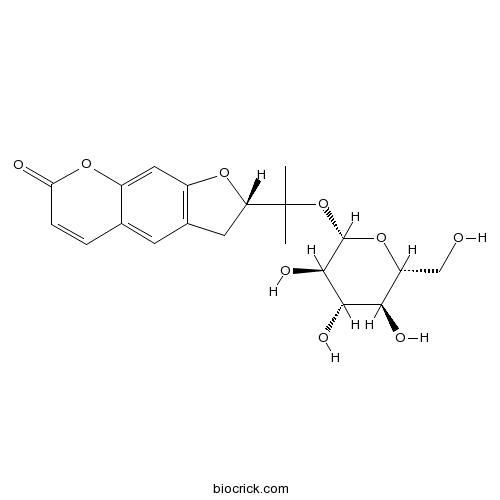Gerbera piloselloides
Gerbera piloselloides
1. The products in our compound library are selected from thousands of unique natural products; 2. It has the characteristics of diverse structure, diverse sources and wide coverage of activities; 3. Provide information on the activity of products from major journals, patents and research reports around the world, providing theoretical direction and research basis for further research and screening; 4. Free combination according to the type, source, target and disease of natural product; 5. The compound powder is placed in a covered tube and then discharged into a 10 x 10 cryostat; 6. Transport in ice pack or dry ice pack. Please store it at -20 °C as soon as possible after receiving the product, and use it as soon as possible after opening.
Natural products/compounds from Gerbera piloselloides
- Cat.No. Product Name CAS Number COA
-
BCN8288
S-(+)-Marmesin13849-08-6
Instructions

-
BCN3617
Ammijin495-30-7
Instructions

-
BCN6307
Arbutin497-76-7
Instructions

Antioxidants from Gerbera piloselloides: an ethnomedicinal plant from southwestern China.[Pubmed: 24895993]
Gerbera piloselloides is a very important ethnobotanical and ethnomedicinal plant used by indigenous peoples in southwestern China. Ten compounds were obtained using activity-guided isolation, including a parasorbosid derivative, two caffeic acid derivatives, two coumarins and five flavonoids, and identified from the whole plant of G. piloselloides. This is the first report of compound 5 as natural product. Six compounds were reported in the Gerbera genus for the first time. The antioxidant activity of all the compounds was evaluated by using ABTS assay, and the chemotaxonomic implication of this study was also discussed.
[Analysis of volatile oil from Gerbera piloselloides by GC-MS].[Pubmed: 24380282]
To identify the chemical components of volatile oil from Gerbera piloselloides.
Two novel dicoumaro-p-menthanes from Gerbera piloselloides (L.) CASS.[Pubmed: 15516764]
Two new type dicoumarins (dicoumaro-p-menthanes), named dibothrioclinins I (1) and II (2) were isolated from the roots and rhizomes of Gerbera piloselloides (L.) CASS., collected in Yunnan Province, China. Their structures were elucidated on the basis of MS, 1D ((1)H-NMR, (13)C-NMR, DEPT and NOE) and 2D ((1)H-(1)H COSY, HMQC, HMBC) NMR spectral analyses. The relative structures of the two compounds were established by NOE difference spectroscopy and further confirmed by single-crystal X-ray diffraction studies.
[The antitussive and de-sputum essential substance from the root of Gerbera piloselloides and its analytical compositions].[Pubmed: 15139127]
To study the chemical constituents of the essential substance from the root of Gerbera piloselloides and its antitussive and de-sputum effects.
Dibothrioclinin I and II, epimers from Gerbera piloselloides (L.) Cass.[Pubmed: 14532681]
Dibothrioclinin I and II, namely (+)-(11R,12S,25R,27S)- and (+/-)-(11RS,12RS,25RS,27SR)-3,3,7,17,21-pentamethyl-4,12,18,26-tetraoxaheptacyclo[15.11.1.0(2,15).0(5,14).0(6,11).0(19,28).0(20,25)]nonacosa-5(14),6,8,10,19(28),20,22,24-octaene-13,27-dione, respectively, are C(30)H(28)O(6) epimers which are derived from two bothrioclinin moieties joined so as to create an additional six-membered ring. Structurally, the epimers differ only by inversion at one C atom of a central ring junction and the corresponding six-membered rings have similar conformations in each molecule, except for one ring adjacent to this inversion site.
[Studies on the chemical constituents from the roots and rhizomes of Gerbera piloselloides].[Pubmed: 12776495]
To study the chemical constituents from the roots and rhizomes of Gerbera piloselloides.
[Pharmacognostical studies on the folk medicine in Sichuan Prov. in China. III. On tu-er-feng derived from Ainsliaea plants].[Pubmed: 2213526]
In the previous paper, Tu-er-feng, one of Chinese folk medicines used locally in Sichuan prov., derived from the whole plants of Gerbera piloselloides of family Compositae, was pharmacognostically reported. In the recent markets, besides this known material, Tu-er-feng made of different components are found. In this paper, the Ainsliaea derivatives are studied to clarify the botanical origins; comparing anatomically with leaves and petioles of thirteen Ainsliaea species growing wildly in Sichuan prov. The result shows that A. glabra and A. rubrinervis are the ingredients.


